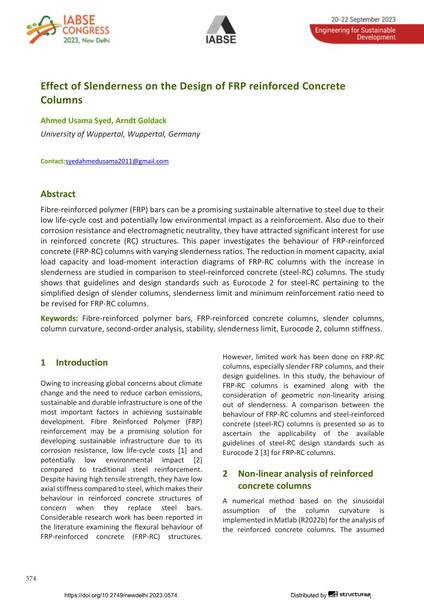Effect of Slenderness on the Design of FRP reinforced Concrete Columns

|
|
|||||||||||
Bibliografische Angaben
| Autor(en): |
Ahmed Usama Syed
(University of Wuppertal, Wuppertal, Germany)
Arndt Goldack (University of Wuppertal, Wuppertal, Germany) |
||||
|---|---|---|---|---|---|
| Medium: | Tagungsbeitrag | ||||
| Sprache(n): | Englisch | ||||
| Tagung: | IABSE Congress: Engineering for Sustainable Development, New Delhi, India, 20-22 September 2023 | ||||
| Veröffentlicht in: | IABSE Congress New Delhi 2023 | ||||
|
|||||
| Seite(n): | 574-582 | ||||
| Anzahl der Seiten (im PDF): | 9 | ||||
| DOI: | 10.2749/newdelhi.2023.0574 | ||||
| Abstrakt: |
Fibre-reinforced polymer (FRP} bars can be a promising sustainable alternative to steel due to their low life-cycle cost and potentially low environmental impact as a reinforcement. Also due to their corrosion resistance and electromagnetic neutrality, they have attracted significant interest for use in reinforced concrete (RC} structures. This paper investigates the behaviour of FRP-reinforced concrete (FRP-RC} columns with varying slenderness ratios. The reduction in moment capacity, axial load capacity and load-moment interaction diagrams of FRP-RC columns with the increase in slenderness are studied in comparison to steel-reinforced concrete (steel-RC} columns. The study shows that guidelines and design standards such as Eurocode 2 for steel-RC pertaining to the simplified design of slender columns, slenderness limit and minimum reinforcement ratio need to be revised for FRP-RC columns. |
||||
| Stichwörter: |
Stabilität Eurocode 2
|
||||
